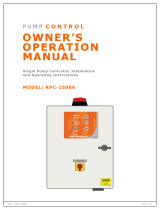
English (GB)
14
8.3 Description of functions
The description of functions is based on the four main menus of
the CU 352 control unit:
•Status
• Operation
•Alarm
•Settings.
The functions apply to all control variants unless otherwise
stated.
8.4 Status (1)
The first status display is shown below. This display is shown
when the power is switched on, and it appears if the buttons of
the control panel remain untouched for 15 minutes.
Fig. 6 Status
Description
No settings can be made in this menu.
The actual value (process value, PV) of the control parameter,
usually the discharge pressure, is shown in the upper right corner
(G) together with the selected setpoint (SP) (H).
The upper half of the display (A) shows a graphic illustration of
the pump system. The selected measuring parameters are shown
with sensor symbol and actual value.
In MPC-E systems where the differential pressure across the
pumps and pump curve data are known, the display shows the
estimated flow rate when the flow rate and speed of the pumps
are within a range where it is possible to estimate the flow rate.
≈ : Indicates that the flow rate is an estimated value.
In the middle of the display, an information field (I) will be shown if
any of the following events occurs:
• Limited operation due to standby pump
• Proportional-pressure influence active
• External setpoint influence active
• Alternative setpoint active
• Low flow boost active
• Pressure relief active
• Clock program active
• Remote-controlled via Ethernet
• Remote-controlled via GENI (RS-485)
• Limited due to reduced operation
• Stopped due to low flow.
The lower display half (B) shows the following:
• the most recent active alarm, if any, and the fault cause with
the fault code in brackets
• system status with actual operating mode and control source
• pump status with actual operating mode.
If the fault is related to one of the pumps, the symbols or
will also be shown in front of the status line (D) of the pump in
question. At the same time, the pump status indicator (E) will
change colour to either yellow or red as described in the table
below. The symbol or will be shown to the right in the top
line of the display (F). As long as a fault is present, this symbol
will be shown in the top line of all displays.
To open a menu line, select the line with [ ∨ ] or [ ∧ ] and press
[ok].
The display makes it possible to open status displays showing the
following:
• actual alarms
• system status
• status of each pump.
Description of pump status
8.4.1 Actual alarms (3.1)
Fig. 7 Actual alarms
Description
This display shows active unreset alarms and warnings.
For further information, see sections 8.6.2 Actual alarms (3.1)
and 8.6.3 Alarm log (3.2).
The estimated flow rate may differ from a measured
value.
If a fault has occurred, the warning symbol or
alarm symbol will be shown in the line (C)
together with the cause and fault code, for instance
"Overtemperature (64)".
Pump status indicator Description
Rotating, green Pump running.
Permanently green Pump ready (not running).
Rotating, yellow Warning. Pump running.
Permanently yellow Warning. Pump ready (not running).
Permanently red Alarm. Pump stopped.





















